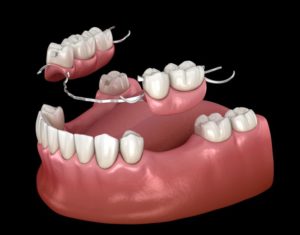
Living without even one of your permanent teeth can limit your daily life, but the problems become even worse when you’re missing multiple teeth. Your self-confidence might plummet, and you may have trouble chewing your favorite foods. Luckily, you have two options for restoring the appearance and function of your smile. Below, a dentist explains the difference between partial dentures and dental bridges – and how to tell which one is right for you!
What Is a Partial Denture?
A partial denture has an acrylic base that is dyed pink to match the color of your gums. Partials also consist of a metal and/or plastic framework that you can secure into place behind your remaining teeth with clasps. On this framework is the exact number of artificial teeth you need to complete your smile, no matter where they’re located in your mouth. They’re customized to mimic the shape, size, and color of your real teeth so that others won’t know the difference!
What Is a Dental Bridge?
Like a partial denture, a dental bridge is also designed to replace one or more missing teeth at the same time. However, a bridge consists of at least three dental crowns strung together, and it relies on two of your remaining teeth to stay in place. The crown at either end of the prosthetic is hollowed out and cemented onto the teeth at either end of the gap. As with partials, dental bridges are personalized to blend in with your natural smile.
Key Differences Between Dental Bridges and Partial Dentures
Dental bridges and partial dentures are both great ways of enjoying a full smile after tooth loss, but they have a few differences to consider:
- Location of missing teeth – A partial can bring back any number of teeth along an arch, but a bridge can only replace teeth that are consecutive.
- Oral health – To support a dental bridge, some enamel must be permanently removed from two of your real teeth. Over time, these teeth may become more vulnerable to sensitivity, decay, or fracture. If your dentist believes you’re at risk for further tooth loss down the road, they may suggest a partial denture to avoid placing too much pressure on your existing teeth.
- Maintenance – Cleaning a partial denture involves taking it out of your mouth and brushing it as well as letting it soak overnight. A bridge, on the other hand, can be brushed while it’s still in your mouth, like real teeth. However, it can be tricky to get the hang of flossing underneath your bridge.
- Sleeping – While a partial denture is designed to be removed while sleeping, you don’t have to worry about taking out a dental bridge before bed.
Which One Should You Choose?
Now that you know the difference between partial dentures and dental bridges, you’re probably wondering which one is best for you. Although you may have an idea, your dentist is ultimately the best person to answer this question. They can evaluate your oral health and determine the best way to replace your missing teeth. Of course, they’ll take your preferences and needs into account.
Whether you choose a dental bridge or a partial denture, rest assured that your new smile will be as lifelike as it is functional!
About the Author
Dr. James Nelson earned his Doctor of Dental Surgery degree from the Louisiana State University School of Dentistry and has almost a decade of experience helping Louisiana families smile more brightly with excellent dental care. He has taken extensive continuing education courses at the prestigious Spear Institute to further his knowledge. At Nelson Dental Care, he provides dental bridges and partial dentures in Metairie, LA made of the highest-quality materials. To find out which solution is right for you, contact Dr. Nelson at 504-887-3311.
